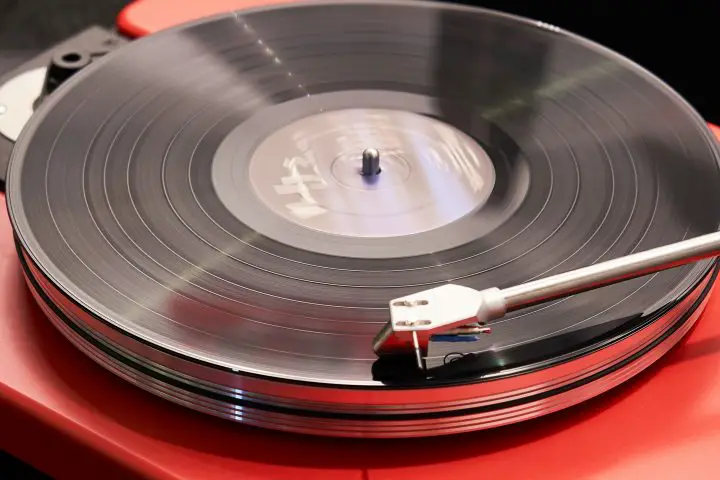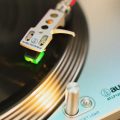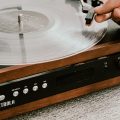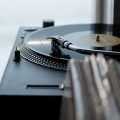This U-Turn Orbit review is worth looking into if you have you got on your eye on a new turntable. The U-Turn Orbit is considered a unique piece because of its hyper-minimal aesthetic, which is something that has been plaguing the design market across the board recently.
In this U-Turn Orbit review, we will explore one of the premier examples of the minimal design aesthetic on modern turntables. We will trawl through the pros and cons and investigate some of the key features. Moreover, we will compare it with a similarly-priced model (the Audio-Technica AT-LP120).

Key Features
We will go through each of the individual features one by one in this U-Turn Orbit review and let you make up your own mind about the U-turn Orbit.
- Acrylic platter provides improved speed consistency and clearer more detailed playback.
- Ortofon OM5E cartridge with elliptical diamond stylus.
- Precision OA2 gimbal tonearm for accurate tracking and low distortion. Features internal anti-skate and adjustable counterweight.
- External belt drive eliminates motor noise and ensures speed consistency (33/45 RP
Prices pulled from the Amazon Product Advertising API on:
Product prices and availability are accurate as of the date/time indicated and are subject to change. Any price and availability information displayed on [relevant Amazon Site(s), as applicable] at the time of purchase will apply to the purchase of this product.
Platter Play
The acrylic platter is made from an acrylic polymer. This can improve the consistency of the speed and, thus, the sound quality overall.
Placing itself firmly on the latter side of the great divide between direct drive and belt drive turntables, this is powered by a belt drive. This purports to negate many of the issues that otherwise plague these kinds of turntables.
The platter of the U-Turn Audio Orbit record player is, therefore, more lightweight, supposedly producing less drag on the motor. This, in turn, is believed to be conducive to a more consistent speed.
The U-Turn Audio Orbit Plus also attempts to grapple with another big issue with platters. Many simply cannot rebuff the plethora of external vibrations that are thrown their way.
This is why the platter is often one of the most important parts of a turntable. It can truly act as a knight in shining armor against the many vibrations that have been known to otherwise ruin a listening experience.
The belief here is that the acrylic in the platter provides greater clarity of sound compared with normal platters. Many of which are made from aluminum and are purported to amplify vibrations considerably. Acrylic is a far more dead and done material. Therefore, it acts as a conduit for far fewer vibrations.
Thus, if you have an issue with your record player skipping, then chances are it could be to do with the issues discussed here.
Cartridge
This is one of the best cartridges to use. Almost to the point of rivaling the prodigal work from the folks over at Audio-Technica. It is really quite impressive for any turntable to just ship with one as standard.
Many models in this price range by other competitors do, in fact, ship with Audio-Technica cartridges. Albeit ones that are in the low-end of quality.
The Ortofon comes with an elliptical diamond stylus. A needle that is supposedly good for all-around uses, flipping between life at home and life in the studio.
This is a moving magnet cartridge. It places itself firmly in the camp of the latter in the great divide between moving coil and moving magnet phono cartridges, with a great sound and accurate tracking.
Within, the magnet is positioned between two sets of fixed coils. The magnet and the coils together form what is essentially a small electromagnetic generator. The magnet vibrates in response to the stylus and needle, tracing through the grooves of the record. This, in turn, induces a current into the coils, which is then sent through the stereo system to the corresponding speakers.
The magnet within is small with little mass. and not joined to the cartridge as it might be otherwise. It is, thus, believed that such a cartridge stylus, if properly adjusted, will follow the grooves more honestly and with less tracking force.
Tonearm
This great turntable comes kitted out with an OA2 Gimbal tonearm. Though this makes it seem like they have used a highly-reputable external manufacturer. In reality, the O and A in the name actually stand for ‘Orbit’ and ‘Audio’ – very cheeky indeed!
Still, I suppose our little investigation into their cheekiness belies the strength of this tonearm a little, too, for it is highly capable.
Being a key part of the turntable, one of the only parts (along with the platter) that actually makes contact with the record itself. Hence, this component is obviously very important.
Lacking a cue lever of any sort, this tonearm truly puts the power in the hands of the user. Much like the adjustable counterweight mechanism that comes attached. This is an essential part of any audiophile turntable. It allows the action of the tonearm to be personalized to the specific circumstances of each individual user. It also ensures that there is no unnecessary weight on the vinyl records.
This is no U-Turn Orbit Basic, either. It comes equipped with anti-skate measures, too, which are also customizable. Coupled with the counterweight, you can rest safe in the knowledge that your tonearm is not going anywhere fast. It will also ride those record grooves like the best cowboy rides an unruly bronco.
Motor
You can tell that U-Turn Audio has given much thought to the construction of a lot of the elements here, and this shows in the motor alone. Many other similarly-priced turntables might otherwise follow the same sort of schematic of existing and older turntables, neglecting the burgeoning vinyl revival and the fact that things can change.
In this instance, they have thought long and hard about the placement of the motor within the midst of all of the other components. Hence, they decided to place it elsewhere.
Thankfully, the belt drive has made this possible for them to do so.
With a direct drive, the motor has to be as close as possible to the platter so that it can start or stop spinning at a moment’s notice. With an external belt drive turntable, the motor can be as far away from the proceedings as fathomable. This is something that many other similarly-priced competitors have failed to grasp.
U-Turn Audio has, however, made use of this fact and placed the motor in a separate part of the turntable. It is isolated from the rest of the electronics and, most importantly, the platter itself.
The motor itself is also worthy of note, even if only for its use of a power adapter. Typically with more backward-thinking models, the conversion of AC to DC power happens within the turntable. Here, the power adapter allows it to happen outside the turntable, thus lowering the hum and noise even more!
The main gripe would be that in order to change the speed of the turntable, the belt has to manually be removed and placed onto a different peg – there is no speed switch!
Weight
As we have already mentioned in this U-Turn Orbit review, the turntable consists of acrylic. This is a far lighter turntable than many others in this price range. This might seem like a bit of a superficial aspect. Best suited, for example, to simply setting the thing up – but this can make all the difference when playing records.
The logic supposedly goes that the heavier a turntable is, the more it presses on the surface upon which it rests. This renders vibrations from below more transferable. Needless to say, these vibrations eventually transfer through all of the components. Even the phono preamp! And then to the needle, where they can cause some serious mischief.
I am not entirely sure how much I bought this, as I would have assumed that a heavier object would be better able to absorb any vibrations.
The turntable itself comes kitted with a clear plastic dust cover. This can add a little weight anyway, though it is, in fact, entirely removable.
Yes, indeed, you can safely set up your record player in your home environment without having to remove the dust cover.
Pros
So, just to distill it all down for you, we will explore some of the pros of this fine vessel:
- Considering the care and attention to detail that has gone into this turntable, it is significantly cheaper than its competitors.
- This is a company that does really put a lot of attention to detail into their work.
- There is a rather extensive range of options for customization before purchase.
- There is plenty of soundproofing from all of the other components. So you can rest assured that when you drop the needle, you are going to hear the record without any interference.
- This is an incredibly durable piece of kit, with many users purporting that it will last for years. The fact that it comes with a 2-year warranty is just the icing on the cake.
Cons
It seems only fair to balance all of these essential pros with the hard cons in this U-Turn Orbit review:
- The manual belt drive is easily the most annoying feature. It renders its functionality more complicated and far less minimalist than the design would otherwise imply. If you are someone who is partial to both 33 1/3 rpm and 45 rpm records, then this is going to royally grind your gears.
- This is atop the fact that the actual mechanism through which to change the speed is not even that easy. It would be all well and good if this aspect was at least fully functional.
- This is even more surprising when we consider just how much thought went into every other aspect of the turntable. Unless it was all just one big fluke.
Comparison ft. Audio-Technica
Both the U-Turn Audio Orbit and the Audio-Technica AT-LP120 are capable of showing you a good time.

They both play at either 33 1/3 rpm or 45 rpm, with no choice for the more extreme 78 rpm vinyl record types. In this way, they are both exemplary turntables in this price category, able to easily outperform more entry-level turntables. But falling a little short when compared to other, more expensive turntables.
True enough, they have similar prices. Though I believe the U-Turn Orbit is more often than not going to cost you a little more than the Audio-Technica. This is despite the fact that the latter arguably has some extra features. I suppose this comes down to the very current trend of fetishizing the hyper-minimal as an aesthetic.
The differences between these two turntables are pretty significant, however. The Audio-Technica is a direct-drive turntable, first and foremost. Whereas we have seen that the U-Turn takes great pride in being belt-driven, to the point of having it externally so that everyone can see it.
Unlike the U-Turn, the Audio-Technica has variable pitch and speed control. This means that you can fine-tune the speed of the platter.
The Audio-Technica also has a speed switch, whereas the U-Turn requires the user to quite literally remove the entire belt and place it onto a different rung in order to play at a different speed.
That being said, the U-Turn does come equipped with a better cartridge out of the box, even despite Audio-Technica being such kingpins when it comes to the construction of cartridges.
Final Tones
So, there you have it!
Hopefully, this exploration of the U-Turn Audio Orbit has been of some use to you in navigating the overwhelming world of turntablism and audiophilia. There is a hell of a lot to choose from out there – more and more minimally designed turntables to discover – so it is our hope that this U-Turn Orbit review has allowed you to come closer to your own epiphanic revelations.
FAQs U-Turn Orbit Review
Is the U-Turn Orbit Plus turntable good?
This remains to be seen by each user, though it certainly delivers in a lot of ways. The isolation of the motor, for example, is top-notch and means that very little external interference gets in the way of the listening experience. However, you have to
remove the belt every time you want to change the speed of the platter. Sure, it results in a better listening experience, but what about the user experience?
Do U-Turn turntables have auto-stop?
They actually do not. This is because the entire turntable is fully manual, to the extent that even the changing of the speed is manual. This is something I have not seen in any other turntables, where for you to change the speed, you have to physically remove the belt and place it on a different rung. .
How do you use an Orbit record player?
You would use an Orbit record player just as you would use any other turntable, though you might want to bear in mind that this one is fully manual. This extends to the manual switching of the speed of the platter, something I have not seen in any other turntables,










